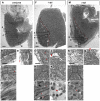Regeneration of cryoinjury induced necrotic heart lesions in zebrafish is associated with epicardial activation and cardiomyocyte proliferation
- PMID: 21533269
- PMCID: PMC3075262
- DOI: 10.1371/journal.pone.0018503
Regeneration of cryoinjury induced necrotic heart lesions in zebrafish is associated with epicardial activation and cardiomyocyte proliferation
Abstract
In mammals, myocardial cell death due to infarction results in scar formation and little regenerative response. In contrast, zebrafish have a high capacity to regenerate the heart after surgical resection of myocardial tissue. However, whether zebrafish can also regenerate lesions caused by cell death has not been tested. Here, we present a simple method for induction of necrotic lesions in the adult zebrafish heart based on cryoinjury. Despite widespread tissue death and loss of cardiomyocytes caused by these lesions, zebrafish display a robust regenerative response, which results in substantial clearing of the necrotic tissue and little scar formation. The cellular mechanisms underlying regeneration appear to be similar to those activated in response to ventricular resection. In particular, the epicardium activates a developmental gene program, proliferates and covers the lesion. Concomitantly, mature uninjured cardiomyocytes become proliferative and invade the lesion. Our injury model will be a useful tool to study the molecular mechanisms of natural heart regeneration in response to necrotic cell death.
Conflict of interest statement
Figures






References
-
- Stoick-Cooper CL, Moon RT, Weidinger G. Advances in signaling in vertebrate regeneration as a prelude to regenerative medicine. Genes & Development. 2007;21:1292–1315. - PubMed
-
- Brockes JP, Kumar A. Comparative aspects of animal regeneration. Annu Rev Cell Dev Biol. 2008;24:525–549. - PubMed
-
- Tanaka EM. Cell differentiation and cell fate during urodele tail and limb regeneration. Curr Opin Genet Dev. 2003;13:497–501. - PubMed
-
- Poss KD, Wilson LG, Keating MT. Heart regeneration in zebrafish. Science. 2002;298:2188–2190. - PubMed
-
- Laube F, Heister M, Scholz C, Borchardt T, Braun T. Re-programming of newt cardiomyocytes is induced by tissue regeneration. J Cell Sci. 2006;119:4719–4729. - PubMed
Publication types
MeSH terms
LinkOut - more resources
Full Text Sources
Medical
Molecular Biology Databases

